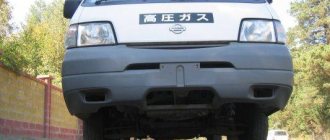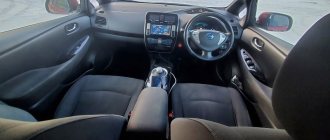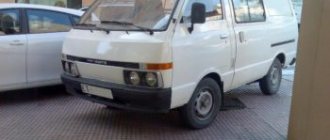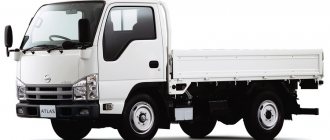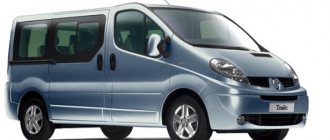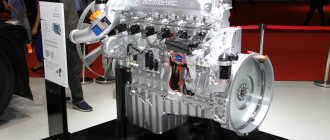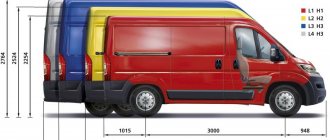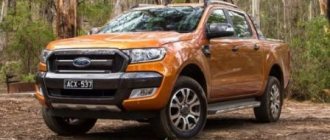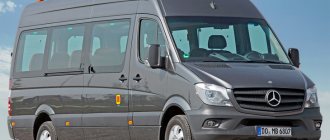Auto Toyota High (High Ace - ace pilot): working character framed by fashionable, urban design.
In the orderly ranks of the Japanese auto giant Toyota there is a car that has survived five generations and is preparing for its 50th anniversary. Having started its journey back in 1967 as a small commercial utility vehicle, the Toyota Hayes today is a station wagon that is still produced both in Japan (the truck is aimed at the domestic market) and in export countries. The exceptions are the USA and Canada, where you cannot purchase a Toyota Hiace truck or its modifications. Despite the fact that the car is widely represented in the markets of export countries in the latest versions, used Toyota Hiaces are very popular.
Second-hand goods are imported into Russia both from the Far East (right-hand drive versions) and from the European part of the continent. Here, as in the CIS countries, the car is used not only for small freight and passenger transportation, but also as special transport for medical institutions. In African countries you can find Toyota trucks of previous generations (manufactured in the 70s and 80s). On dusty African roads, they regularly perform the function of public passenger transport, which has earned them great respect from the local population.
History of the development of the Nissan Vanette model range
The history of the development of the Nissan Vanette model range can be divided into four generations.
First generation.
The first representative of the model range was the 1978 minivan, which replaced the Nissan Cherry Cab.
Representatives of this generation were produced in three modifications: a minivan with a seating capacity of 9 people, a truck and a van. Models of this generation had a completely classic appearance for this class of cars.
Second generation.
In 1985, another breakthrough in technological progress significantly influenced the next changes in the design of the minivan: improvement of the air conditioning system, introduction of an innovative braking system (disc brakes), modernization of the car interior, and changes to the instrument panel.
The exterior of the car has also undergone changes, which made it more proportional and interesting for the buyer. In addition, the line of carburetor and injection engines (88 - 120 hp) was replenished with a 2-liter turbodiesel (79 hp). Some representatives of this model were equipped with a 4-speed automatic transmission.
Third generation.
The third modification of the Nissan Vanette was introduced in 1994.
Now the minivan has acquired the features of a European style. The body is represented by a half-hood layout, which made it possible to distribute the weight of the minivan, increase its load capacity to 740 kg, and increase the useful volume to 4.8 m3. The “engine compartment” was also modernized; the car was now equipped with:
- 1.6 liter petrol engine. with a power of 98 horsepower and a 2-liter – 126 horsepower;
- diesel engine CD 20T with a volume of 2 and 2.3 liters
The transmission was represented by a 5-speed manual gearbox and an automatic gearbox. It was during this period that new modifications of the Vanette Cargo and Vanette Combi began to be produced.
Fourth generation.
The fourth generation of this car was released in 1999. The exterior of the car acquired rounded shapes and a bumper that protruded strongly forward. The range of supplied motors has been significantly expanded.
Owner reviews
Alexander, Vladivostok. Toyota Hiace car, mileage 280 thousand km.
Diesel is a rather delicate system, but the 1KZ Efi Turbo seems to have been created specifically for Russia. There are not many horses, but the timing is good. Reliability - not a single breakdown during the entire run. I am sure that the diesel fuel heating system and air conditioners, which cool both the engine and the interior in hot weather, play an important role in this (there is an intercooler and circuit antifreeze, cooling through the clutch), because correct, smooth heating is very important for diesel engines. And our car starts at -35 on standard batteries after several days of inactivity, and at -40 it can still drive and drive with the generator turned off (this happened). We change the oil according to the norm, no topping up. Diesel fuel consumption is 8-9, appetites increase in winter. I fill up at the same gas stations, but the diesel fuel there is the most common. Recently they started knocking - the upper ball joints were replaced (unfortunately they only come with a crab, so the price can reach 12-14 thousand). The rest of the repairs are all minor tuning.
Andrey, Yakutsk. Toyota HIACE 2003
The car was inherited from my father several years ago. The 1RZ engine was running its course, the appetite is now wow. The car was working, we carried 1-2 tons of cargo to the store every day. Over the entire period, spark plugs and belts were changed (there is no timing belt here), oil was poured every 8-9 thousand. km, changed the air filter 4 times. The song ended when the cardan flew off, a replacement was not found, and was left standing in the garage. It sat for 2 years, found the cardan, replaced it - no problems! I've been using it for 3 years now. We changed all the ball joints, shock absorbers once, changed the crosspieces, and some little rubber bands. Of all the spare parts, only the crosspieces are original from Toyota HIACE, the rest are from disassembly. Regarding the rubber bushings on all Toyota Hayes cars, it’s annoying that everything is covered, to remove one you need to unscrew the entire gas tank. Fuel consumption is 10-12 liters, but under load it can burn all 16. The controls are very good, precise, although of course you can’t jump from the spot.
Technical characteristics of cars of the Nissan Vanette model range
| I | II | III | IV | |
| Start year of release | 1978 | 1985 | 1994 | 1999 |
| Model | S120 | S22 | S20, SE, SK | S21, SK |
| Dimensions, m | 3.9x1.6x1755 | 4.36x1.69x1.9 | 4.365x1.69x1.9 | 4.285x1.69x1.985 |
| (Cargo 2.3D) | 4.5x1.695x1.98 | |||
| Clearance, cm | 17 | 15-18,5 | 18,5 | 17 |
| Load capacity, kg | 600-865 | 750-865 | 600-1000 | 750 |
| Turning radius | 4,6-4,9 | 4,3-5,1 | ||
| Tire size | 195/70R15 92Q | 195/70R14 90S | 175/R14-6PRLT | |
| Wheelbase, m | 2,075 | 2,35 | 2,735 | 2,22 |
| Power steering | No | Yes | Yes | Yes |
| Fuel tank, l | 50-55 | 60 | 60 | 53 |
Suzuki Jimny became a truck to survive in Europe
At the beginning of the year, we talked about how Suzuki was preparing to turn the new Jimny into a commercial model of the N1 class, so as not to completely remove the SUV from the European market, and here is the result. The transformation into a van did not cost much: the rear seats were removed, a mesh partition was installed behind the front ones, the rear windows and the tailgate window were preserved. The cargo compartment volume is 863 liters, which is 33 liters more than a regular Jimny with the rear seats folded down. Load capacity - 345 kg.
In terms of hardware, the cargo Jimny is no different from the passenger one: that is, it is a full-fledged SUV with a reduction gear in the transfer case, but the 1.5-liter naturally aspirated gasoline engine (102 hp, 130 Nm) is now combined only with a 5-liter engine. manual transmission, meaning a 4-speed automatic is no longer available. Maximum speed is 145 km/h.
Prices and configurations have not yet been announced, but, most likely, the cargo Jimny has lost some passenger options - for example, it is unlikely that you can get cast rather than stamped wheels in stock.
The passenger Jimny completely disappeared from sale in Europe in July: the presence of the model on some consumer sites (for example, in German) should not be misleading - the configurator does not work, it is impossible to place an order. According to Autocar magazine, the commercial version will have a limited run over the next year, meaning there may not be enough for everyone.
The restrictions are obviously again related to the environment: the cargo Jimny emits 174 grams of CO2 per kilometer, while the standard is 147 g/km for light commercial vehicles. For passenger cars, let us remind you that the limit from next year is even stricter - 95 g/km, but this is the general target declared by the European Union, and the specific volume of permitted CO2 emissions is calculated for each major automaker individually using a formula, which we described in detail in a separate material.
Suzuki, according to the CarSalesBase resource, last year sold 260,383 cars in Europe, that is, it does not belong to a large manufacturer (for this you need to sell more than 300 thousand cars a year), and therefore the requirements for it in terms of CO2 emissions are softer: it is necessary reduce them by 47% compared to 2007. That is, despite the absence of plug-in hybrids and electric vehicles in the model line, Suzuki will remain on the European market, but it needs to get rid of the most toxic models and not sell more than 300 thousand cars a year, so as not to run into a fine: 95 euros for each car sold for every extra gram of CO2 per kilometer driven.
By the way, a plug-in hybrid will soon appear in the European Suzuki line - this is the Across crossover, which is a clone of the Toyota RAV4, but it is still unknown when to expect the first Suzuki electric car, but most likely it will also be a clone of the “alien” model.
As for Russia, we still have the passenger Suzuki Jimny: in the first half of this year it found 323 buyers. The current price range is from 1,639,000 to 1,849,000 rubles.
Engine Nissan Vanette
Nissan Vanette cars were equipped with four-cylinder gasoline and diesel engines of varying power. Let's look at two engine modifications.
| Characteristics | Gasoline engine | Diesel engine |
| Working volume, l. | 1,8 | 2,0 |
| Rated power | 66 (90) kW (hp) | 63 (86) kW (hp) |
| Maximum torque, Nm | 135 | 178 |
Features of Toyota Hiace
Modern Toyota Hiace trucks are classified as minibuses. The capacity of the cargo-passenger version reaches 12 people: 11 passenger seats and one driver's seat. However, if necessary, the seats in the cabin can be easily removed, which makes it possible to transport large cargo. The Toyota Hiace body is made of solid metal and is based on the H200 platform in the “short” version:
- The wheelbase length is 2570 mm;
- Body length – 4695 mm;
- Width - 1695 mm;
- Body height – 1908 mm;
and with an extended wheelbase:
- The wheelbase length is 3110 mm;
- Body length – 5380 mm;
- Width - 1880 mm;
- Body height – 2285 mm.
The Toyota Hiace utility vehicle is equipped with comfortable seats upholstered in durable fabric. The seats can be removed to transport bulky loads.
The dimensions of Hayes allow you to feel comfortable in urban cargo transportation. Good maneuverability and stability even on bad roads is achieved due to the type of suspension and ground clearance of 185 mm. The minimum turning diameter is 6.2 meters. At the front, the car is equipped with an independent torsion bar suspension on double wishbones with a stabilizer bar, and at the rear there is a dependent spring-type suspension with telescopic shock absorbers. The body itself is assembled in two versions: four and five doors, with an additional side door, one of which is sliding, with a built-in sliding window - for convenient loading, the doorway is significantly widened, and the floor in the cabin is equipped with a special anti-slip material. The rear door lifts up and is equipped with an additional brake light.
Interesting fact. The fourth-generation Hayes model, released in the late 80s on the H100 platform with rear-wheel drive (all-wheel drive was optionally available), received many flattering reviews as a highly reliable cargo carrier. Extremely interested in producing a successful model under their own brand, three Chinese brands acquired a license for Toyota Hiace: Foton, BAW and Jiangnan. In addition to China, the model was assembled in South America and Africa. Modifications were available with both a gasoline engine (volume 2 liters) and a diesel engine (volume 3 liters) with 4- and 5-speed manual transmissions.
In this version, the Toyota Hiace truck first seriously interested auto manufacturers in other countries. China became the first owner of the license to assemble Hayes.
Technical characteristics of Toyota Hiace
Currently, Toyota Hiace mini trucks are available with rear-wheel drive. Transmission – 5-speed manual gearbox. The braking system includes ventilated brake discs at the front and drum brakes at the rear wheels. The power unit is represented by a 4-cylinder diesel engine 1KZ-T (supplemented in later versions with an EFI system - electronic injection) with the following characteristics:
- Volume - 3 liters;
- Maximum power – 136 hp. at 3400 rpm;
- Maximum torque – 300 Nm at 1200-2400 rpm;
More on the topic: Mercedes Atego 1828 and 1823: review of German mid-ton trucks
as well as a gasoline version (the modern version - 3RZ-FE is equipped with a DOHC system with four valves per cylinder, which allows reducing crankshaft inertia and achieving good power output):
- Volume – 2.7 liters;
- Maximum power – 151 hp. at 4800 rpm;
- Maximum torque – 241 Nm at 3800 rpm;
- Fuel type: gasoline with an octane rating of at least 95.
The Toyota Hiace is equipped with a rear door with a lifting rather than a hinged mechanism. Together with the high body, this makes the loading process easier.
With a total vehicle weight of 3050 kg, the minimum fuel consumption of the Toyota Hiace is stated as 8.7 l/100 km in the diesel version and 12.4 liters for the gasoline version during a mixed driving cycle. The fuel tank has a capacity of 70 liters. The environmental standard of the car is EURO-4. The basic safety system includes: two front airbags for the driver and front passenger, seat belts with pretensioners on all seats, an ABS anti-lock braking system (popular in most modern cars), fog lights, and an emergency hammer for breaking glass.
Like everything produced under the Toyota brand, the Japanese Hayes is, without a doubt, an example of high quality and great reliability. Not only half a century of production history speaks in favor of this. but also reviews from Toyota Hiace owners, emphasizing the durability and convenience of the truck. In Japan itself, it often ranks first on the lists of the most popular cars... among car thieves. In addition to the fact that cars are cleverly exported from Japan to the secondary market of other countries, where the demand for minibuses is always high, Hayes engines are sold to equip boats and small vessels in the countries of Southeast Asia.

